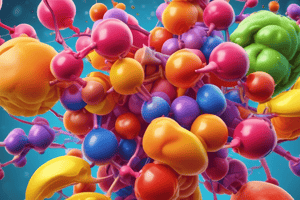Podcast
Questions and Answers
What is the primary function of glycogen in the body?
What is the primary function of glycogen in the body?
- Transport of oxygen in the blood
- Formation of cell membranes
- Structural support in plant cells
- Energy storage in the liver (correct)
Which of the following describes dehydration synthesis?
Which of the following describes dehydration synthesis?
- It adds water to break down molecules.
- It occurs only in the presence of enzymes.
- It creates polysaccharides from monosaccharides without water.
- It removes water to form bonds. (correct)
Which of the following compounds is NOT a polysaccharide?
Which of the following compounds is NOT a polysaccharide?
- Cellulose
- Fructose (correct)
- Glycogen
- Starch
What role do proteins play in biological systems?
What role do proteins play in biological systems?
Which elements are NOT commonly found in organic compounds?
Which elements are NOT commonly found in organic compounds?
What distinguishes disaccharides from monosaccharides?
What distinguishes disaccharides from monosaccharides?
Which of the following is a characteristic of lipids?
Which of the following is a characteristic of lipids?
Which of the following best describes the structure of a monosaccharide?
Which of the following best describes the structure of a monosaccharide?
What distinguishes phospholipids from triglycerides in terms of structure?
What distinguishes phospholipids from triglycerides in terms of structure?
Which statement accurately describes the function of DNA?
Which statement accurately describes the function of DNA?
How do polar and nonpolar substances differ in their interaction with water?
How do polar and nonpolar substances differ in their interaction with water?
How are hydrogen bonds formed in water molecules?
How are hydrogen bonds formed in water molecules?
What is the primary role of RNA in a cell?
What is the primary role of RNA in a cell?
Which of the following accurately describes saturated and unsaturated fatty acids?
Which of the following accurately describes saturated and unsaturated fatty acids?
Which feature is characteristic of steroids among lipids?
Which feature is characteristic of steroids among lipids?
What is true about the structure of DNA compared to RNA?
What is true about the structure of DNA compared to RNA?
What property of water is demonstrated by its ability to stabilize temperature?
What property of water is demonstrated by its ability to stabilize temperature?
Which of the following correctly describes an exergonic reaction?
Which of the following correctly describes an exergonic reaction?
What describes the role of a catalyst in a chemical reaction?
What describes the role of a catalyst in a chemical reaction?
Which process is an example of cohesion in water?
Which process is an example of cohesion in water?
In which type of reaction is energy absorbed from the surroundings?
In which type of reaction is energy absorbed from the surroundings?
Which statement is true regarding the solubility of substances in water?
Which statement is true regarding the solubility of substances in water?
Which law justifies the need to balance a chemical equation?
Which law justifies the need to balance a chemical equation?
What is the solvent in an aqueous solution?
What is the solvent in an aqueous solution?
Flashcards
Hydrophobic
Hydrophobic
Describes molecules that repel water.
Fatty acid chain
Fatty acid chain
Long chain of carbon and hydrogen atoms in the lipid molecules and phospholipids.
Saturated fat
Saturated fat
A type of fat in which all carbon atoms are bonded to the maximum number of hydrogen atoms. Solid at room temp
Unsaturated fat
Unsaturated fat
Signup and view all the flashcards
Triglyceride
Triglyceride
Signup and view all the flashcards
Nucleotide
Nucleotide
Signup and view all the flashcards
DNA
DNA
Signup and view all the flashcards
RNA
RNA
Signup and view all the flashcards
Monomer
Monomer
Signup and view all the flashcards
Polymer
Polymer
Signup and view all the flashcards
Dehydration synthesis
Dehydration synthesis
Signup and view all the flashcards
Hydrolysis
Hydrolysis
Signup and view all the flashcards
Monosaccharide
Monosaccharide
Signup and view all the flashcards
Disaccharide
Disaccharide
Signup and view all the flashcards
Polysaccharide
Polysaccharide
Signup and view all the flashcards
Glucose
Glucose
Signup and view all the flashcards
Water's high boiling point
Water's high boiling point
Signup and view all the flashcards
Exergonic reaction
Exergonic reaction
Signup and view all the flashcards
Endergonic reaction
Endergonic reaction
Signup and view all the flashcards
Activation energy
Activation energy
Signup and view all the flashcards
Catalyst
Catalyst
Signup and view all the flashcards
Law of Conservation of Matter
Law of Conservation of Matter
Signup and view all the flashcards
Aqueous solution
Aqueous solution
Signup and view all the flashcards
Hydrophilic substances
Hydrophilic substances
Signup and view all the flashcards
Study Notes
Studying That Suits You
Use AI to generate personalized quizzes and flashcards to suit your learning preferences.




